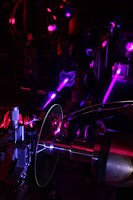Getting CD quality recordings with a device you can carry in your shirt pocket.
Many serious photographers have come to realize that recording
ambient sounds can be a great way to create a background audio track for their
slideshows. The challenge however is to record a quality track without hauling
microphones, xlr cables and recording decks onto location. Enter Blue’s Mikey
2G for iPod.
The Mikey 2G is a compact solution, small enough to fit
easily within the palm of your hand and weighs less than three ounces. Made to
clip into the bottom of your iPod, it turns your device into a high end cardioid
recording device, capable of 44.1 kHz/16 bit recordings.
There are three gain settings (via a simple slider) that
adjust for any environment. Many devices I’ve tried have such a slider, but the
difference is often unperceivable. With Mikey, the difference is very noticeable
and works exactly as you’d expect. Now you can record that guy who never speaks
above a whisper as well as the heavy metal rock star with his 16 giant
amplifiers.
In addition to its own microphone, it features a
pass-through 3.5mm line-input for direct recording of other audio sources such
as your guitar, CD player or soundboard.
The recording head is pivoted so it can be directed at the
sound source whether you are hand-holding the unit or laying it down on a
table/shelf. There are seven distinct detent points to give you a range of
angles.
Blue makes a recording app (Blue FiRe 1.5) for your iPhone
or iPod that is free on the iTunes site. They also offer a paid app (FiRe 2) with
significantly more features, including file sharing with iTunes, SoundCloud and
Dropbox.
But, now the good/bad news:
Mikey 2G is an analog recording device and does not work with the latest
version 4 iPhone or the iPads, which switched to digital recording technology. The
good news however is that it is a perfect way to utilize those old iDevices
that you had set aside when you upgraded.
It will still work with iPod
touch 1G, 2G, 3G; iPod nano 2G, 3G, 4G, 5G; iPod classic; iPod 5G. It gave me a
reason to pull my 3G out of the closet and carry it on all my photo shoots. (Stay
tuned however, rumor has it that a digital version is in the works.)
Check out all the details
on Mikey 2G for iPod at the Blue website and start
collecting some serious, quality background tracks. Mikey 2G, MSRP $79.99, is
available at Amazon.com and Apple.com. For local retailers, visit www.bluemic.com/dealerlocator .









